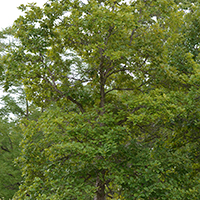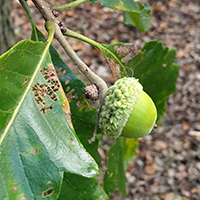What swamp white oak looks like
Size and shape
- Reaches 22 metres high.
Leaves
- Shiny dark green leaves up to 17 centimetres long.
- Fuzzy pale green undersides.
- Leaves have rounded lobes.
Bark
- Grey-brown in colour.
- Ridged, with peeling scales.
Flowers
- Appear in early spring when leaves are about one-third developed.
- Has both male and female flowers.
Fruit
- Acorns have a long stalk.
- Scales on the acorn cap are pointed and curve backward.
Where swamp white oak is found
Swamp white oak is uncommon but can be found in Southwestern Ontario, in the Niagara Region and in an isolated stand near the Ontario-Quebec border.
What you need to know to grow swamp white oak
- Moisture: grows best in moist soils, tolerates seasonal flooding and does not like drought.
- Shade: will grow in partial shade or full sun.
- Soil: grows best in rich, slightly acidic soils.
- Cautions:
- Planting: It is best to transplant field-grown and bare root oaks in spring before they leaf out. Smaller container-grown trees can be moved in spring or fall if you keep soil moist.
- Disease: oak wilt is caused by an invasive fungus that has been found in Southern Ontario. To minimize the risk of oak wilt, save pruning for before April and after July, when beetles thought to transport the fungus are less active.
Benefits and uses of swamp white oak
Wildlife benefits
Acorns from swamp white oak are a food source for squirrels, other small mammals and some bird species.
Commercial uses
Wood from swamp white oak is used for:
- cabinetry, furniture, trim, and flooring
- fence posts
- casks and barrels
- veneer
- shipbuilding
Fun facts about swamp white oak
- Acorns with their caps on are not good to plant.
- As the name suggests, this species is closely related to our native white oak but prefers wetter and denser soils.
- Swamp white oak is one of the easiest oak species to transplant.
Updated: January 10, 2024
Published: July 18, 2014




